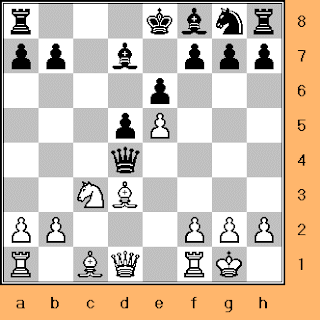
• • >>>>Advance Variation 5.Qb6 6 a3 Nh6 7 b4 [C02] We haven’t looked at the Advance Variation for a while. After 3 e5 c5 4 c3 Nc6 5 Nf3 Qb6 6 a3, players are still contesting the oldest and most popular line, that is, 6.Nh6 7 b4 cxd4 8 cxd4 Nf5 9 Bb2 Bd7. Then 10 g4 Nge7 11 Nc3 Na5 has been seen in several games on this site, and the ongoing interest indicates that both sides feel it’s still worth playing: This month’s two games Wroclaw 2017 and Huai'an 2017 serve as a nice overview for this line. Advance Variation 5.Qb6 6 Be2 cxd4 7 cxd4 Nh6 8 Bxh6 Qxb2 [C02] Computer engines fight over the strangest things. For over 100 years, after 3 e5 c5 4 c3 Nc6 5 Nf3 Qb6 6 Be2 cxd4 7 cxd4 Nh6, White has played 8 Nc3 with the idea 8.Nf5 9 Na4, or 8 b3 Nf5 9 Bb2 intending 9.Bb4+ 10 Kf1. There are many thousands of games with those lines, but hardly any with 8 Bxh6, which has been considered theoretically inferior due to 8. Cyborg P3600 Drivers here. Qxb2 9 Nbd2 gxh6: But Black, a pawn up, has real weaknesses here, and his extra doubled h-pawn isn’t much to brag about, so it’s surprising that we haven’t seen this position more often (I cite a game by Harikrishna in the notes, but that’s the only high-level example).
View the chess games from these files with PGN Mentor, the very best program available for working with PGN files. Portable Game Notation. Modern Queen Pawn, Classical Queen Pawn, Modern King Pawn, Classical King Pawn, Flank and Unorthodox, Players, Events. Sicilian, Moscow Variation 20361 games, 1.e4.
Anyway,, chess.com Computers 2017, shows that White’s next move is important: Instead of 10 Nb3! Bb4+ 11 Kf1 with a complex, balanced game, Stockfish played 10 Rb1 and never managed to equalize. Throughout, Black’s bishop pair had too much influence. Milner-Barry Gambit 9 Nbd2 [C02] In the Milner-Barry Gambit with 6 Bd3 (instead of 6 Be2) 6.cxd4 7 cxd4 Bd7 8 0-0 Nxd4, 9 Nbd2 (Nun's move) has gotten the reputation of being the most respectable Milner-Barry line for White: Here Acqui Terme 2017 saw 9.Nxf3+ 10 Nxf3 h6, a rather slow approach that has nonetheless scored quite well for Black.
In the game, White failed to develop any pressure and ended up a pawn down for nothing. Advance Variation 5.Bd7 6 Be2 Nge7 7 0-0 Ng6 [C02] I couldn’t resist showing a one-minute game(! Rockwell Factorytalk Activation Keygen. ) which is relevant to theory: chess.com Speed 1m+1spm 2017. The game went 3 e5 c5 4 c3 Nc6 5 Nf3 Bd7 6 Be2 Nge7 7 0-0 Ng6 8 g3 Be7 9 h4 0-0 10 h5 Nh8: Black’s setup was first championed by Korchnoi. The amazing thing is how well both sides played. As far as the theory goes, it seems that after 11 h6, instead of the automatic 11.g6, Black should have considered the unknown move 11.g5!?
• • Tarrasch Variation 3.Nf6 4 e5 Nfd7 5 Bd3 c5 6 c3 Nc6 7 Ne2 cxd4 8 cxd4 f6 9 exf6 Qxf6 [C06] After 3 Nd2 Nf6 4 e5 Nfd7 5 Bd3 c5 6 c3 Nc6 7 Ne2 cxd4 8 cxd4 f6 9 exf6, Black plays 9.Nxf6 a vast majority of the time, but there have always been players who experimented with 9.Qxf6: As mentioned above, this is a sideline that has never been worked out in detail. Oddly enough, considering its relative rarity, the move’s success rate in both over-the-board and correspondence play has been impressive. I’ll show two games from this month with 10 Nf3 h6 11 0-0 Bd6. White won both, but hardly as a direct result of the opening.
In Baku 2017, White played 12 Ng3 0-0 13 Bc2, a natural sequence that has been played from time to time: Black normally plays 13.Rd8 and.Nf8 in such positions, but he chose the similar 13.Rf7, which worked out reasonably well. White got a very small advantage, allowed a central advance, and then blundered, after which Black had a potentially winning combination. Black missed that but still kept the better game until returning the favor and getting mated. In Budapest 2017, White played the modest but effective 12 Be3 0-0 13 Rc1, finding a very clever followup to 13.Rf7 in 14 Bb5!: Now Black has to respond to the threat on c6 and couldn’t find anything better than 14.Ndb8, giving White time to establish some positional pressure in the center.
In fact, things weren’t so bad, and Black stayed only moderately worse until falling for a nice trick that forced immediate resignation. • • Till next month, John >>>>Please post you queries on the, or subscribers can write to me at if you have any questions or queries.
The diagrammed position is reached after 1.e4 e6 2.d4 d5 3.e5 c5 4.c3 Nc6 5.Nf3. Although the advance variation is already reached after 3.e5, I will concentrate on this position and not look into alternatives. Furthermore, I will write from a black perspective and concentrate on lines with 5.Qb6 and.Nh6 to follow. The analysis draws heavily on Watson's 'Play the French', a book which I heartily recommend to any French player. But before we delve into the actual lines, it might be wise to consider the strategic outlines of the battle ahead. The advance variation is in this sense interesting for many variations of the French, because the action will revolve around the central pawn structure white: d4,e5, black d5,e6, which is common in many other French lines as well.